- Skip to primary navigation
- Skip to main content
- Skip to primary sidebar

Activities to Teach How to Write A Thesis Statement
Research Writing , Secondary Literacy , Writing
If there’s any literacy skill you would want your English Language Arts students to master, it would probably be how to write a thesis statement . If you want to teach your students how to write powerful, eloquent, and exceptionally captivating thesis statements, then you’ll love the activities in this article.
The key to any good essay is a strong thesis statement. A strong thesis statement sets the tone and clarifies the author’s purpose : it tells you the writer’s opinion, along with the level of thought and criticism that has gone into formulating it.
A strong thesis statement also creates an alluring introduction paragraph. This makes each paper in your grading pile a lot more inviting.
How do you teach students to write a thesis statement to make their audience continue reading? This blog post explores six activities to teach how to write a thesis statement.

1. Differentiate Between Strong and Weak Thesis Statements
Writing a thesis statement might be a new skill for your students. Thesis statements are often taught as a topic sentence or the “whole essay boiled down into one sentence.” This can be a challenging concept for your students to grasp.
To teach how to write a thesis statement, have a discussion about what makes a strong thesis statement. You can turn this into a collaborative lesson by brainstorming clarifying statements ; these statements dictate what a thesis is and is not.
For example: “ A proper thesis statement is written in one sentence ,” or “ a proper thesis statement is directly related to the rest of the essay .” This is a great opportunity to teach students the difference between concepts like a “topic sentence” or a “hook.”
Your students can use this free bookmark to differentiate between a strong thesis statement and a weak one. This slideshow lesson also explores clarifying statements with detailed examples.

2. Evaluate Thesis Statement Examples
Now that students have plenty of guidelines, challenge their understanding by evaluating thesis statement examples . You can use thesis statement examples from past students’ essays. You can even write your own examples based on the clarifying statements you create with your class.
If you’re open to your students receiving constructive, anonymous criticism , you can even have them write a thesis statement and evaluate each one as a class. I’ve had success with providing students with a thesis statement topic and having them write a thesis statement. Then, I prompt them to swap with their elbow partner to offer feedback.
If you’d rather provide a comprehensive list of thesis statements that reflect the common errors you would typically see in students’ essays, there are several student examples in this introductory lesson on how to write a thesis statement – this is one of my favourite activities for teaching thesis statement writing!
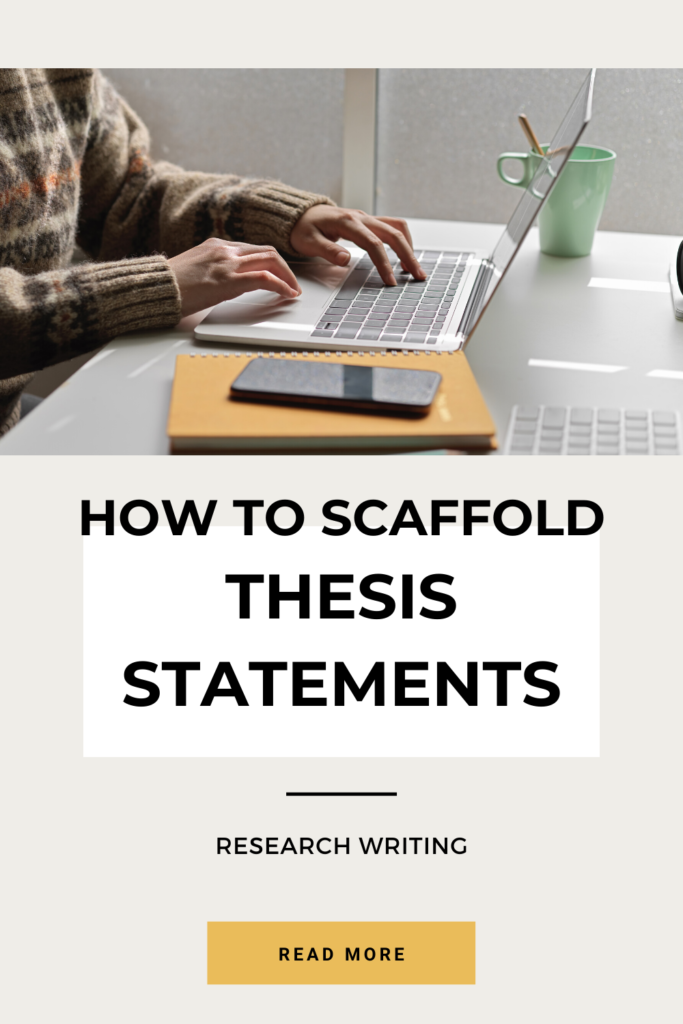
3. Provide a Thesis Statement Template
One of the easiest ways to teach how to write a thesis statement is to offer a thesis statement template . There are a variety of thesis statement templates that students can use as a framework for their essays. I start with a basic template that involves the three parts of a thesis statement: a topic, position, and evidence . I then demonstrate to students how they can create variations of this template, depending on which order they introduce each part. You can find examples for each template in these thesis statement handouts .
You can also introduce a few sentence styles to your students. These styles scaffold eloquent thesis statements. They also offer students the space to articulate their thoughts without exceeding the one-sentence limit.
Sentence Styles for the Three Parts of a Thesis Statement
Here are a few sentence styles that incorporate the three parts of a thesis statement. Each style also includes an example written by a real student:
- Style A : “Noun phrase; Noun phrase; Noun phrase – Independent Clause” Example: “The promotion of hygiene; the presence of medical professionals; the prevention of death – these are all reasons why supervised injection services are an important facet of public health.”
- Style B : If (subject + verb + object phrase), if (subject + verb + object phrase ), if (subject + verb + object phrase ), then (independent clause) Example: “If taxpayers do not wish to have their money allocated to cruelty, if more than 100 million animals die from animal testing a year, if alternatives to animal testing exist, then governments should ban the practice of testing on animals.”
- Style C : Independent clause: subject + verb, subject + verb, subject + verb Example: “College education should be entirely funded by the government: student debt would be eliminated, education would not be commodified, and access to education would not be exclusive to privileged people.”
All of these sentence styles are outlined in these practice worksheets for how to write a thesis statement, with writing prompts to reinforce each thesis statement template through repeated practice.
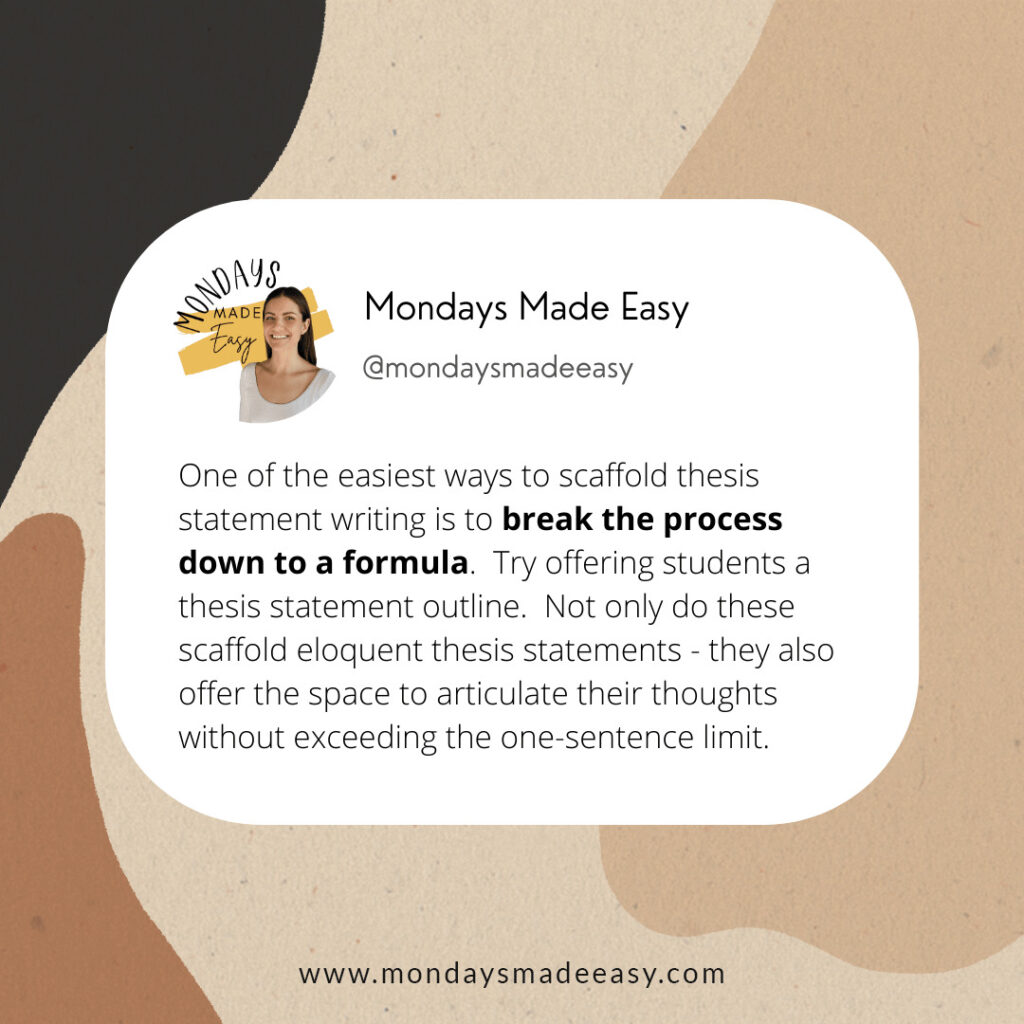
4. Daily Practice Activities to Teach How to Write a Thesis Statement
One of the most effective ways to teach how to write a thesis statement is through repeated practice. You can do this by incorporating daily bell ringers into your persuasive writing unit. To assign this activity, I provide students with three topics to choose from. I then prompt them to develop an opinion and write a thesis statement for one.
I’ll also include bell ringers that provide a thesis statement that students need to evaluate. Students really enjoy these drills! They get the opportunity to develop opinions on interesting topics, and many of them choose to explore these ideas as the subject of their final research paper.
If you’re looking for pre-made worksheets with thesis statement activities, these daily thesis statement bell ringers include one month’s worth of thesis statement prompts, graphic organizers, and templates in both digital and ready-to-print format.
5. Use a Self-Assessment Thesis Statement Anchor Chart
You can provide students with a thesis statement anchor chart to reference the guidelines and rules they’ve learned. A personalized anchor chart is best – like this free thesis statement bookmark – so that students can have it on hand while they are reading and writing.
You can distribute the anchor chart at the beginning of your research paper unit. Students can refer to it while evaluating thesis statement examples or completing daily practice activities. A thesis statement anchor chart has been a complete game-changer in my classroom, and I’m pleased to learn that many of my students have held on to these after completing my course.

6. Provide Engaging Thesis Statement Topics
You can collaborate with your students to generate an engaging list of good topics for thesis statements. Start by writing down every topic that your students suggest. Then, you can narrow this list down to avoid broad, far-reaching thesis statements that lead to a watered-down essay. When I make this list with my students, we end up with topics that are truly engaging for them. I also have the opportunity to clarify which topics might be a little too vague or broad for an exceptional essay.
For example, students often suggest topics like “racism” or “the problem with school.” These are learning opportunities to demonstrate to students that a great thesis statement is the essential starting point for an even greater essay.
To elaborate, a topic like racism has different implications all over the world. It is far too complex to explore in a single, 750-word essay. Instead, we work together to narrow this topic down to something like “racism in the media,” or even better, “representation in Hollywood.”
Additionally, a topic like “the problem with school” is more of a conclusion. To solve this, we work backward to identify some of the aspects of our school that make it an obstacle . This can include uniforms, early starts, or cell phone policies. This process leads students to a more concise topic, like “cell phone policies in twenty-first-century schools.”
If you’re looking for engaging thesis statement topics to inspire your students, I’ve included a list of 75 argumentative essay topics in this practice unit for how to write a thesis statement .
Tying it All Together
There are plenty of fun thesis statement activities and practice lessons that you can incorporate into your curriculum. Give thesis statements the love and attention they deserve in the classroom – after all, they truly are the most important part of a research essay.
All of the worksheets, lessons, and activities explored in this blog post are included in Mondays Made Easy’s unit for teaching how to write a thesis statement . This bundle has everything you need to teach your students how to master their thesis statements and apply these essential literacy skills to their writing.
- Writing Worksheets and Other Writing Resources
- Thesis, Analysis, & Structure
Thesis Activity
About the slc.
- Our Mission and Core Values

One way to think about a thesis statement is:
An effective thesis is one that is not obvious; rather it is one that is discussible, arguable, and interesting.
Avoid self-evident statements.
In the US, movie stars are greatly admired.
A strong thesis will give readers an idea of the general direction of your paper and the evidence you will provide.
Because definitions of obscenity change as society changes, the Supreme Court has handed down three contradictory decisions on censorship in the past five years.
A few things to keep in mind:
- A thesis must be a complete sentence(s), not a fragment(s).
- A thesis should not be worded as a question.
- A thesis should neither be too broad nor too specific.
- A thesis should not contain elements which are extraneous or irrelevant to your paper.
- A thesis should avoid phrases like I think and in my opinion because they weaken the writer's argument.
Having said all of that, let's venture into never-never land, take a trip to the world of happily-ever-after. Let's look at fairy tales.
Take a common fairy tale. Little Red Riding Hood , for example. Your average tale of good vs. evil, right?
In my opinion, Little Red Riding Hood is a classic tale of good versus evil.
Now, there's a thesis that is sure to keep you up at night. Interesting. Innovative. Imaginative. I think not.
Let's try something else. How about:
Because she dares to defy societal norms of acceptable female behavior, Little Red Riding Hood faces death at the hands of the Big Bad Wolf, who embodies patriarchy.
Little Red Riding Hood serves as a feminist tale, demonstrating how an independent, intelligent woman subverts the entrenched forces of male power and privilege.
The forest in Little Red Riding Hood--with its various elements of danger, fear, and foreboding--symbolizes a young girl's rite of passage into womanhood; by challenging the elements in the forest, the naive and trusting Little Red Riding Hood emerges an empowered, mature, confident young woman.
Television shows and movies also offer a wealth of possible thesis statements. Consider the following:
As the middle child, Jan Brady is insecure and demonstrates a negative self-perception: she feels inferior to Marcia, who embodies the qualities of the "ideal" teenager and to Cindy, the "innocent" child and center of the family's attentions.
While appearing to be a simplistic situation comedy about a group of castaways, Gilligan's Island is actually a complex representation of vice; each of the characters represents one of the seven deadly sins.
While Star Trek : The Next Generation may appear to represent an ideal version of a multicultural, gender-equal society, the command structure on the Enterprise, headed by Picard and Riker, reinscribes western, patriarchal notions of power.
Although praised for its realism, Saving Private Ryan glorifies American patriotism and heroism, excluding alternative perspectives.
Now it is your turn. Construct an interesting, compelling thesis using a fairy tale, television show, popular song, or movie.
Luisa Giulianetti Student Learning Center, University of California, Berkeley ©1998 UC Regents
This work is licensed under a Creative Commons Attribution-NonCommercial-NoDerivs 3.0 Unported License.
Fun Activities for Developing a Strong Thesis Statement
Stacy alleyne.

Thesis statements are statements that are arguable and that state a writer’s stance on a subject. Typically, a good thesis statement serves as a blueprint of an essay or paper that readers can use to follow along. Thesis statements give focus and organization to your writing, but sometimes they can be challenging to write.
Explore this article
- Interesting Examples
- Thesis Puzzles
1 Interesting Examples
When teaching thesis development, try using interesting examples that will engage students. If you know that your students are basketball lovers, a three-part thesis using a basketball superstar will both engage their interest and help them learn thesis formation. “Michael Jordan is the best basketball player in history because of his jump shot, stats, and work ethic.” This three-part thesis is arguable and stated authoritatively. Using examples that students can relate to or are interested in will help them to form their own thesis statements.
Making a game out of identifying the thesis statements in the writings of others is a fun way to help students develop strong thesis statements. Give student groups three model essays and highlighters. Set a timer and reward the groups that highlight the correct thesis statement in all three essays. Adding competition to thesis development is another way to engage students.
Have students debate each others thesis statements. This is a good way to have students test whether their statements are arguable. If a student’s thesis can’t be argued, they will have to rework their statement so that it is arguable. Have student’s write their thesis on a small piece of paper and put the papers into a bowl. Have each team choose a paper from the bowl to see which thesis statement will be debated. Ask students whether each thesis is an effective thesis statement.
4 Thesis Puzzles
Introduce students to thesis writing by using manipulatives and group work. Give student groups copies of the body and conclusion of an essay and have them read it. Cut the thesis statement into pieces word by word. Create similar thesis statements and cut them up as well. Give each group a stack of the cut-up words and have them put the correct words together to make the best thesis statement. Once students have pasted the words onto construction paper with the body and conclusion of the essay, have them report back to the class on why they chose the thesis that they did. This combination jigsaw/thesis activity will help students learn how to create thesis statements and have fun at the same time.
- 1 High School Lesson Plan: How to Write a Thesis Statement
- 2 Colorado State University: Thesis Statements
About the Author
Stacy Alleyne is a certified English teacher with a BA in English and graduate work in English, education, journalism and law. She has written numerous articles and her own dining column for the "Gazette."
Related Articles

Critical Thinking Activities for Middle School

Sentence Structure Games for Middle School

How to Write an Essay on Encouraging Students to Volunteer

Catholic Fun & Games for Second-Graders

Pronouns & Antecedents Activities for Elementary Students

Fruits of the Spirit Games

How to Teach Dialogue in Writing to Younger Students

Fun Classroom Debate Games

Games to Teach Figure of Speech

Activities on Diphthongs for Primary Grades

Honesty Crafts for Kids

Fun Ways to Learn Spelling Words

Types of High School English Classes

How to Think Outside the Box with Creativity Exercises

Hands-on Activities for Compound Sentences

How to Use Fun Activities to Help Kids Learn Participles

What Skills Must a Student Develop to Write an Effective...

Beatitude Games

Indoor Team-Building Activities for Kids

What Is a Hook Paragraph in an Essay?
Regardless of how old we are, we never stop learning. Classroom is the educational resource for people of all ages. Whether you’re studying times tables or applying to college, Classroom has the answers.
- Accessibility
- Terms of Use
- Privacy Policy
- Copyright Policy
- Manage Preferences
© 2020 Leaf Group Ltd. / Leaf Group Media, All Rights Reserved. Based on the Word Net lexical database for the English Language. See disclaimer .
Fun Ways to Teach Thesis Statements for High Schoolers
- Trent Lorcher
- Categories : High school english lesson plans grades 9 12
- Tags : High school lesson plans & tips
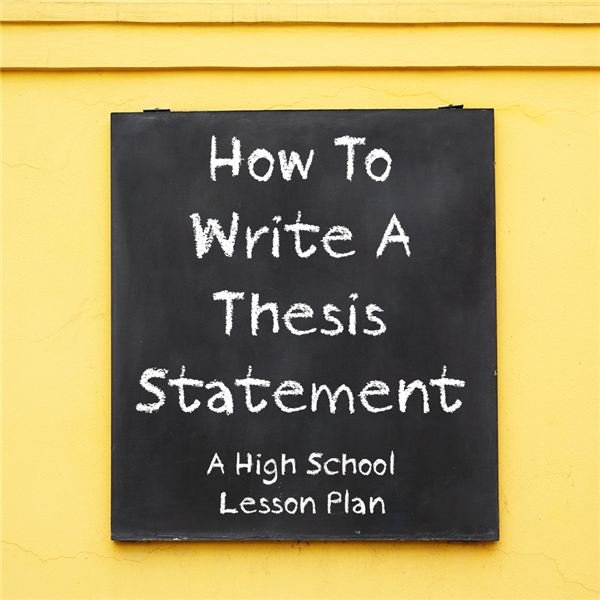
The Thesis Statement Dilemma
[caption id="" align=“aligncenter” width=“600”]
On my way out the door, I noticed all the English teachers were busily grading essays . “Hey, Bob,” I shouted as I stumbled into his classroom, “Not done with those essays yet? I finished mine an hour ago.” “How’d you grade them so fast?” he asked. “It’s simple,” I responded, “I didn’t teach my students how to write a thesis statement, so grading their essays was easy. I just gave them all F’s. While you guys waste your time teaching valuable lessons and then having to actually grade their essays, we watch movies.” “So, none of your students know anything about writing?” “Nope.” “You’re a disgrace!” Bob shouted. He moved toward me, stapler in hand. Next thing I remember, I was surrounded by angry tax-payers. Angry tax-payer #1 shouted, “Get up you thief! Our tax dollars pay your salary and you’re supposed to teach the children of this great state how to write! I suggest you start doing your job tomorrow morning, or you’ll pay dearly!” The angry tax-payer clubbed me with a ruler and knocked me out again. When I awoke, Bob was asking me if I wanted to learn some fun ways to teach thesis statements to my students. I now share these ideas with you.
What to Do Before Writing

- You must begin with a topic question. If your instructor has assigned an essay question to answer, this step has been done for you. If you are doing a research paper, take time to come up with a good topic question.
- You must form an opinion and state it clearly. Do not be wishy-washy.
- Be sure you have approached your evidence fairly, without bias.
- Consider both sides of a controversial issue.
- Once you’ve established the topic question, a clear position, and objectivity, you’re ready to write a thesis statement.
What Is a Thesis Statement?
Students have heard the term thesis statement hundreds of times by the time they reach high school, yet have only a vague understanding of what one is. Your first responsibility is to teach them that a thesis statement:
- Presents your opinions or thoughts on a subject or an issue. You cannot write an essay without one.
- Must contain a subject + an opinion.
- Answers the topic question (the one you created or the one presented to you by the instructor).
TIP : A thesis statement should never contain the following: in my opinion, I think, I believe , etc. Tell them that the entire thesis represents what they believe. However, it may be helpful for students to begin their thesis statement rough draft with i_n my opinion, I believe, or I think_ to make sure they are expressing their thoughts or opinion on a specific subject or issue. When writing the final draft, simply eliminate those phrases.
How to Teach Students to Write A Thesis Statement
It is important to demonstrate the difference between good and bad thesis statements. These instructions will help you teach the former:
- Good Example: Success is a result of doing the right things consistently.
- Bad Example: In a world full of success gurus and books about success, it becomes ever so more important to delineate the one trait that ultimately determines success: doing the right things consistently.
- Good example: The key to successful dieting is focusing on a specific goal.
- Bad example: T_he key to successful dieting is focusing on a specific goal, which is also the key to successfully running a business and coaching a football team._
- Good example: Lebron James’ ability to score, pass, and rebound make him the league’s most valuable player.
- Bad example: Does Lebron James’ ability to score, pass, and rebound make him the league’s most valuable player?
- Bad Example: Lebron James’ ability to score, pass, and rebound just might make him the league’s most valuable player.
Write It Out
Knowing what to do and actually doing it are not the same thing. The following steps will help you and your students write clearly:
- Write several trial statements: writing is a process - you don’t have to get it perfect on the first try. Teach your students to revise their work .
- If you’re having trouble deciding which side to take on a controversial issue, write your thesis statement from two different points of view. Then decide which one better represents your opinion. If you still can’t decide, list facts on both sides of the issue and decide which facts make a more persuasive argument.
Evaluating the Work
You’ve spent a lot of valuable classroom time teaching thesis statements, but your lesson is not finished without teaching your students how to evaluate their writing. Instruct students to use the following questions to analyze their statement:
- Good example: Romeo’s prior feelings for Rosaline diminish the credibility of his love for Juliet.
- Bad example: This essay examines whether or not Romeo’s prior feelings for Rosaline diminish his love for Juliet.
- Good example: Juliet was not the first woman to capture Romeo’s fancy; she was, however, the one who affected him the most.
- Bad example: Romeo loved Juliet with all his heart, but he loved Rosaline too. It could be argued they were both his favorite.
- Bad example: Immature, whiny, male-pig Romeo, a male harlot, ruined precious Juliet whom he loved no more than Rosaline.
More Teaching Ideas
The following activities will help reinforce the concept.
- Have students create thesis statements on a slice of paper. Collect the paper and read them to the class. Have the class vote on them.
- Do the same activity, but use individualized white boards to record judgments .
- Read the thesis statements anonymously. The ones that do not qualify get tossed in the garbage can (visualizing what happens to writing is powerful). Give students a chance to rewrite until they get it right.
- Write random topics on the board and have groups of students brainstorm good ones.
- Make the thesis statements part of a writing challenge .
- Require that students get thesis statements approved before writing an essay.
Click here for a complete 1st semester curriculum map for language arts with lesson plans and links. I hope you learned some fun ways to teach thesis statements to your students. If you have other tips, be sure to leave them in the comments. Image by Nicholas Jackson from Pixabay
Reading Worksheets, Spelling, Grammar, Comprehension, Lesson Plans
How to Write a Thesis Statement
About this worksheet:.
Practice developing thesis statements with this writing introduction worksheet! Students will learn how to improve their writing with a strong, attention grabbing thesis statement. This activity helps build writing skills by asking students to create a statement for the topics provided, such as: “What was the greatest challenge in your life?”.
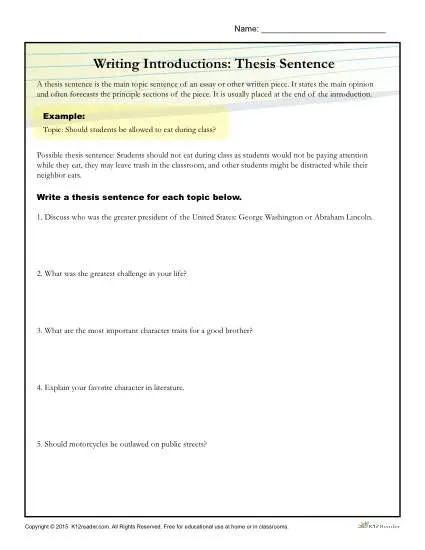

Thesis Statements
What this handout is about.
This handout describes what a thesis statement is, how thesis statements work in your writing, and how you can craft or refine one for your draft.
Introduction
Writing in college often takes the form of persuasion—convincing others that you have an interesting, logical point of view on the subject you are studying. Persuasion is a skill you practice regularly in your daily life. You persuade your roommate to clean up, your parents to let you borrow the car, your friend to vote for your favorite candidate or policy. In college, course assignments often ask you to make a persuasive case in writing. You are asked to convince your reader of your point of view. This form of persuasion, often called academic argument, follows a predictable pattern in writing. After a brief introduction of your topic, you state your point of view on the topic directly and often in one sentence. This sentence is the thesis statement, and it serves as a summary of the argument you’ll make in the rest of your paper.
What is a thesis statement?
A thesis statement:
- tells the reader how you will interpret the significance of the subject matter under discussion.
- is a road map for the paper; in other words, it tells the reader what to expect from the rest of the paper.
- directly answers the question asked of you. A thesis is an interpretation of a question or subject, not the subject itself. The subject, or topic, of an essay might be World War II or Moby Dick; a thesis must then offer a way to understand the war or the novel.
- makes a claim that others might dispute.
- is usually a single sentence near the beginning of your paper (most often, at the end of the first paragraph) that presents your argument to the reader. The rest of the paper, the body of the essay, gathers and organizes evidence that will persuade the reader of the logic of your interpretation.
If your assignment asks you to take a position or develop a claim about a subject, you may need to convey that position or claim in a thesis statement near the beginning of your draft. The assignment may not explicitly state that you need a thesis statement because your instructor may assume you will include one. When in doubt, ask your instructor if the assignment requires a thesis statement. When an assignment asks you to analyze, to interpret, to compare and contrast, to demonstrate cause and effect, or to take a stand on an issue, it is likely that you are being asked to develop a thesis and to support it persuasively. (Check out our handout on understanding assignments for more information.)
How do I create a thesis?
A thesis is the result of a lengthy thinking process. Formulating a thesis is not the first thing you do after reading an essay assignment. Before you develop an argument on any topic, you have to collect and organize evidence, look for possible relationships between known facts (such as surprising contrasts or similarities), and think about the significance of these relationships. Once you do this thinking, you will probably have a “working thesis” that presents a basic or main idea and an argument that you think you can support with evidence. Both the argument and your thesis are likely to need adjustment along the way.
Writers use all kinds of techniques to stimulate their thinking and to help them clarify relationships or comprehend the broader significance of a topic and arrive at a thesis statement. For more ideas on how to get started, see our handout on brainstorming .

How do I know if my thesis is strong?
If there’s time, run it by your instructor or make an appointment at the Writing Center to get some feedback. Even if you do not have time to get advice elsewhere, you can do some thesis evaluation of your own. When reviewing your first draft and its working thesis, ask yourself the following :
- Do I answer the question? Re-reading the question prompt after constructing a working thesis can help you fix an argument that misses the focus of the question. If the prompt isn’t phrased as a question, try to rephrase it. For example, “Discuss the effect of X on Y” can be rephrased as “What is the effect of X on Y?”
- Have I taken a position that others might challenge or oppose? If your thesis simply states facts that no one would, or even could, disagree with, it’s possible that you are simply providing a summary, rather than making an argument.
- Is my thesis statement specific enough? Thesis statements that are too vague often do not have a strong argument. If your thesis contains words like “good” or “successful,” see if you could be more specific: why is something “good”; what specifically makes something “successful”?
- Does my thesis pass the “So what?” test? If a reader’s first response is likely to be “So what?” then you need to clarify, to forge a relationship, or to connect to a larger issue.
- Does my essay support my thesis specifically and without wandering? If your thesis and the body of your essay do not seem to go together, one of them has to change. It’s okay to change your working thesis to reflect things you have figured out in the course of writing your paper. Remember, always reassess and revise your writing as necessary.
- Does my thesis pass the “how and why?” test? If a reader’s first response is “how?” or “why?” your thesis may be too open-ended and lack guidance for the reader. See what you can add to give the reader a better take on your position right from the beginning.
Suppose you are taking a course on contemporary communication, and the instructor hands out the following essay assignment: “Discuss the impact of social media on public awareness.” Looking back at your notes, you might start with this working thesis:
Social media impacts public awareness in both positive and negative ways.
You can use the questions above to help you revise this general statement into a stronger thesis.
- Do I answer the question? You can analyze this if you rephrase “discuss the impact” as “what is the impact?” This way, you can see that you’ve answered the question only very generally with the vague “positive and negative ways.”
- Have I taken a position that others might challenge or oppose? Not likely. Only people who maintain that social media has a solely positive or solely negative impact could disagree.
- Is my thesis statement specific enough? No. What are the positive effects? What are the negative effects?
- Does my thesis pass the “how and why?” test? No. Why are they positive? How are they positive? What are their causes? Why are they negative? How are they negative? What are their causes?
- Does my thesis pass the “So what?” test? No. Why should anyone care about the positive and/or negative impact of social media?
After thinking about your answers to these questions, you decide to focus on the one impact you feel strongly about and have strong evidence for:
Because not every voice on social media is reliable, people have become much more critical consumers of information, and thus, more informed voters.
This version is a much stronger thesis! It answers the question, takes a specific position that others can challenge, and it gives a sense of why it matters.
Let’s try another. Suppose your literature professor hands out the following assignment in a class on the American novel: Write an analysis of some aspect of Mark Twain’s novel Huckleberry Finn. “This will be easy,” you think. “I loved Huckleberry Finn!” You grab a pad of paper and write:
Mark Twain’s Huckleberry Finn is a great American novel.
You begin to analyze your thesis:
- Do I answer the question? No. The prompt asks you to analyze some aspect of the novel. Your working thesis is a statement of general appreciation for the entire novel.
Think about aspects of the novel that are important to its structure or meaning—for example, the role of storytelling, the contrasting scenes between the shore and the river, or the relationships between adults and children. Now you write:
In Huckleberry Finn, Mark Twain develops a contrast between life on the river and life on the shore.
- Do I answer the question? Yes!
- Have I taken a position that others might challenge or oppose? Not really. This contrast is well-known and accepted.
- Is my thesis statement specific enough? It’s getting there–you have highlighted an important aspect of the novel for investigation. However, it’s still not clear what your analysis will reveal.
- Does my thesis pass the “how and why?” test? Not yet. Compare scenes from the book and see what you discover. Free write, make lists, jot down Huck’s actions and reactions and anything else that seems interesting.
- Does my thesis pass the “So what?” test? What’s the point of this contrast? What does it signify?”
After examining the evidence and considering your own insights, you write:
Through its contrasting river and shore scenes, Twain’s Huckleberry Finn suggests that to find the true expression of American democratic ideals, one must leave “civilized” society and go back to nature.
This final thesis statement presents an interpretation of a literary work based on an analysis of its content. Of course, for the essay itself to be successful, you must now present evidence from the novel that will convince the reader of your interpretation.
Works consulted
We consulted these works while writing this handout. This is not a comprehensive list of resources on the handout’s topic, and we encourage you to do your own research to find additional publications. Please do not use this list as a model for the format of your own reference list, as it may not match the citation style you are using. For guidance on formatting citations, please see the UNC Libraries citation tutorial . We revise these tips periodically and welcome feedback.
Anson, Chris M., and Robert A. Schwegler. 2010. The Longman Handbook for Writers and Readers , 6th ed. New York: Longman.
Lunsford, Andrea A. 2015. The St. Martin’s Handbook , 8th ed. Boston: Bedford/St Martin’s.
Ramage, John D., John C. Bean, and June Johnson. 2018. The Allyn & Bacon Guide to Writing , 8th ed. New York: Pearson.
Ruszkiewicz, John J., Christy Friend, Daniel Seward, and Maxine Hairston. 2010. The Scott, Foresman Handbook for Writers , 9th ed. Boston: Pearson Education.
You may reproduce it for non-commercial use if you use the entire handout and attribute the source: The Writing Center, University of North Carolina at Chapel Hill
Make a Gift
First list item. Add your own content here or connect to data from your collection.
Second list item. Add your own content here or connect to data from your collection.
Third list item. Add your own content here or connect to data from your collection.
- Feb 18, 2020
Thesis Drawing Game
This activity was developed and submitted by Maureen Wieland, ABD from Purdue University .

Topic/Purpose/Learning Objective:
Learning the importance of a clear and complete thesis statement.
This activity can be used for any basic communication, public speaking, or even writing class as the concept of a clear thesis is relevant to all.
Students often struggle with how to construct a full thesis statement and even forget to include this important part of a presentation in their own speeches and outlines. This activity should be conducted after students have already been exposed to the structure of a thesis statement and works well as a supplementary activity to do during the same class period in which you have lectured on this topic. It's a bit humorous and will help these concepts stick.
Procedure/Steps:
Time Requirement: One round takes approximately 10 minutes. I tend to play 3 rounds when I used this activity in one 50-minute class.
Materials: Blank pieces of paper (at least 1 per student per round you intend to play) and writing utensils.
Instructions:
Divide your class into groups of 5 to 10 and have each group sit in a circle. Give each student one piece of blank paper and instruct them to write a complete and detailed thesis statement appropriate for an informative presentation at the top of the paper. Make sure they keep their writing hidden from their group. No one but them should know what they wrote. You may want to remind them about the structure and purpose of a thesis statement before they get started (important pieces such as general purpose and specific purpose statements often are forgotten by students). Allow them to be creative with these thesis statements. Some of my favorite thesis statements produced through this activity involved "informing the audience about the potential dangers of owning a unicorn as a pet" and "informing the audience about how to teach your dog to skateboard."
After each student has written their thesis statement, have them pass their paper to the person on their right. Each student should have a piece of paper with a thesis statement that the person to their left has written. They should then read that thesis statement to themselves and attempt to create a drawing that accurately represents that statement. Make sure they don't take up too much space with their drawings as this process will need to be repeated a few times. Give your students about 1 minute to draw.
Then instruct them to fold over the top of their paper so that you cannot see the original thesis statement anymore. You should only be able to see their drawing now. Once they have covered up the original thesis statement, have them pass their papers again to the right.
Now they will only see a drawing without knowing what the thesis statement originally was. They should then interpret the drawing as a best as they can into a written thesis statement. Again give them 1 minute to write out their thesis statement based off of the drawing. Then, have each student fold over their papers again so that the first drawing is now covered. Once they have done that, have them again pass their papers to the right. They should only see a thesis statement again.
Make sure you instruct your students of when they should pass their papers. Without this guidance, there tends to be confusion and a build up of papers on one student's desk per group. Repeat this process of drawing and writing as many times as you would like or as many as there is space on the paper. I have found that you can usually fit thesis-drawing-thesis-drawing-thesis-drawing-thesis comfortably on one piece of paper.
Once you have stopped the process of passing papers, have students find the paper they originally started with, the one with the thesis statement they wrote. They will most likely have to unfold all the folds in the paper to find it. Give them a few minutes to marvel at the success (or lack of success) in the progression of their thesis statement. Invite students to share this progression with the rest of the class. There are usually a few that are quite hilariously bad or incredibly good.
Discussion:
While this activity can be very fun and silly, it is also important to tie it back to the importance of a quality thesis statement. Make sure to take the time to debrief the successes or failures of some of the thesis statements in the class. Some possible questions include:
Was the original thesis statement detailed enough to inform the artist what the speech would be about? Did it include the general purpose and specific purpose statements? How could it have been worded to be even more clear?
Was the original thesis statement expressed as a declarative sentence? Was it too broad of a topic to fit in one presentation?
Why was writing a thesis statement based off of a drawing difficult? Or did students find it easy?
Why are thesis statements an important part of presentational speaking?
As an audience member, how would having a good or bad thesis statement be helpful or harmful to understand a presentation?
At what part of the speech writing process should students create a detailed thesis statement?
Assessment Recommendations:
My students absolutely love this activity! It's fun and creative and results in some funny thesis transformations that they can keep. The last time I ran this activity with my presentational speaking class, I asked them at the end of the second round if they had learned the goal of the activity (besides just having fun) and I had one student so perfectly sum it up I could have shed a tear. They catch on about the importance of being clear and detailed in their thesis statement writing and how a thesis that is ambiguous leads to disaster. That same class period, I had to remind them that the class period had ended and that they could leave because they were trying to fit in another riveting round. They still ask almost every week if we can play it again. Overall, I have found this activity to be very effective and incredibly fun.
References for more information on active and engaging classroom activities:
Kuh, G.D. (2009) What student affairs professionals need to know about student engagement. Journal of College Student Development, 50 (6), 683-706.
McClenney, K., Marti, C., & Adkins, C. (2006) Student engagement and student outcomes: Key findings from CCSSE validation research. Austin, TX: Community College Survey of Student Engagement.
Umbach, P.D. & Wawryznski, M.R. (2005) Faculty do matter: The role of college faculty in student learning and engagement. Research in Higher Education, 46 (2), 153-184.
Zhang, Q. & Zhang, J. (2006) Instructors' positive emotions: effects on student engagement and critical thinking in the US and Chinese classrooms. Communication Education, 62 (4), 395-411.
- U.S. Locations
- UMGC Europe
- Learn Online
- Find Answers
- 855-655-8682
- Current Students
UMGC Effective Writing Center Designing an Effective Thesis
Explore more of umgc.
- Writing Resources
Key Concepts
- A thesis is a simple sentence that combines your topic and your position on the topic.
- A thesis provides a roadmap to what follows in the paper.
- A thesis is like a wheel's hub--everything revolves around it and is attached to it.
After your prewriting activities-- such as assignment analysis and outlining--you should be ready to take the next step: writing a thesis statement. Although some of your assignments will provide a focus for you, it is still important for your college career and especially for your professional career to be able to state a satisfactory controlling idea or thesis that unifies your thoughts and materials for the reader.
Characteristics of an Effective Thesis
A thesis consists of two main parts: your overall topic and your position on that topic. Here are some example thesis statements that combine topic and position:
Sample Thesis Statements
Importance of tone.
Tone is established in the wording of your thesis, which should match the characteristics of your audience. For example, if you are a concerned citizen proposing a new law to your city's board of supervisors about drunk driving, you would not want to write this:
“It’s time to get the filthy drunks off the street and from behind the wheel: I demand that you pass a mandatory five-year license suspension for every drunk who gets caught driving. Do unto them before they do unto us!”
However, if you’re speaking at a concerned citizen’s meeting and you’re trying to rally voter support, such emotional language could help motivate your audience.
Using Your Thesis to Map Your Paper for the Reader
In academic writing, the thesis statement is often used to signal the paper's overall structure to the reader. An effective thesis allows the reader to predict what will be encountered in the support paragraphs. Here are some examples:
Use the Thesis to Map
Three potential problems to avoid.
Because your thesis is the hub of your essay, it has to be strong and effective. Here are three common pitfalls to avoid:
1. Don’t confuse an announcement with a thesis.
In an announcement, the writer declares personal intentions about the paper instead stating a thesis with clear point of view or position:
Write a Thesis, Not an Announcement
2. a statement of fact does not provide a point of view and is not a thesis..
An introduction needs a strong, clear position statement. Without one, it will be hard for you to develop your paper with relevant arguments and evidence.
Don't Confuse a Fact with a Thesis
3. avoid overly broad thesis statements.
Broad statements contain vague, general terms that do not provide a clear focus for the essay.
Use the Thesis to Provide Focus
Practice writing an effective thesis.
OK. Time to write a thesis for your paper. What is your topic? What is your position on that topic? State both clearly in a thesis sentence that helps to map your response for the reader.
Our helpful admissions advisors can help you choose an academic program to fit your career goals, estimate your transfer credits, and develop a plan for your education costs that fits your budget. If you’re a current UMGC student, please visit the Help Center .
Personal Information
Contact information, additional information.
By submitting this form, you acknowledge that you intend to sign this form electronically and that your electronic signature is the equivalent of a handwritten signature, with all the same legal and binding effect. You are giving your express written consent without obligation for UMGC to contact you regarding our educational programs and services using e-mail, phone, or text, including automated technology for calls and/or texts to the mobile number(s) provided. For more details, including how to opt out, read our privacy policy or contact an admissions advisor .
Please wait, your form is being submitted.
By using our website you agree to our use of cookies. Learn more about how we use cookies by reading our Privacy Policy .
thesis games
All Formats
Resource types, all resource types.
- Rating Count
- Price (Ascending)
- Price (Descending)
- Most Recent
Thesis games
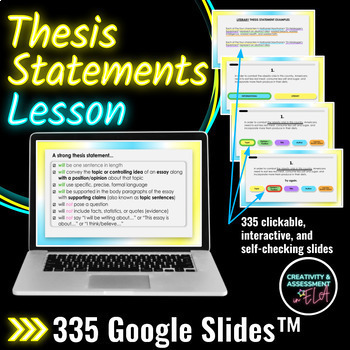
Thesis Statements Mini Lesson Interactive Game Activity with Google Slides
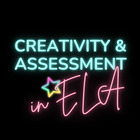
- Google Slides™
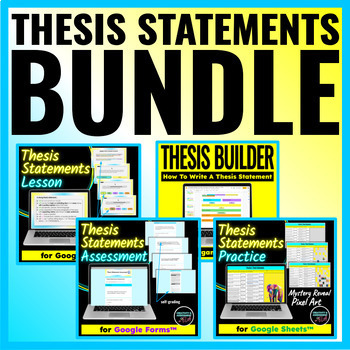
Thesis Statements BUNDLE | Digital Lesson Game , Practice, & Formative Assessment

Thesis Statement Scoot Game /Task Cards

Yes/No Thesis Game

Thesis Throwdown Class Game : Middle & High School Thesis Writing Practice

- Google Drive™ folder

Thesis Statements Jeopardy Game

"The Most Dangerous Game " Essay Prompt, Thesis and Topic Sentences + More!

- Google Docs™
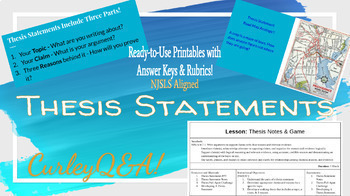
Thesis Statements - Thesis Game Challenge & Step By Step Writing

Writing an Effective Thesis Statement: Slide Presentation and Blooket Game Link

- Internet Activities
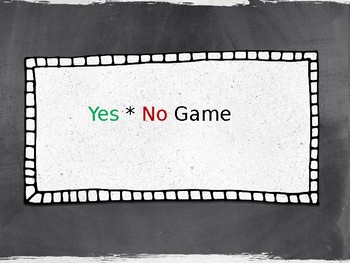
"I Dissent" board game FRQ thesis practice

- Word Document File
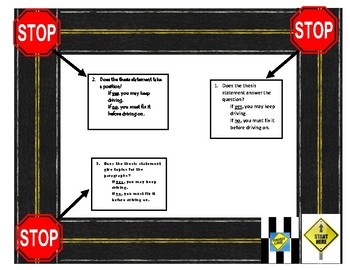
Thesis Game

Game Winning Thesis Statements!

Thesis Statement Practice Task Cards

Music Theory BOOM Cards BUNDLE - Music Games for Google Classroom™ and more!

How to Write a Thesis Statement Mini Lesson and Activities

Thesis Statement Digital Escape Room Argumentative Writing Digital Resources

- Google Apps™
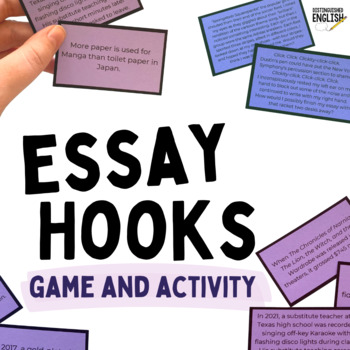
Fun Essay Hooks Writing Game and Practice Activity for Middle School ELA

Literary Analysis Essay Writing and Thesis Statement With Short Film Activities

CSI: Protestant Reformation Activity - Fake News Game - Printable & Digital

Escape Room Break Out Box Game , Parts of an Essay (Mini)

Literary Terms Review Game or Task Cards - 100 Questions

“The Most Dangerous Game ” Character Analysis Unit -Digital for Distance Learning
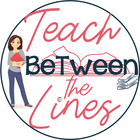
Argumentative Essay Writing - Rubric - Graphic Organizer - Violent Video Games

- Easel Assessment
- We're hiring
- Help & FAQ
- Privacy policy
- Student privacy
- Terms of service
- Tell us what you think
While Sandel argues that pursuing perfection through genetic engineering would decrease our sense of humility, he claims that the sense of solidarity we would lose is also important.
This thesis summarizes several points in Sandel’s argument, but it does not make a claim about how we should understand his argument. A reader who read Sandel’s argument would not also need to read an essay based on this descriptive thesis.
Broad thesis (arguable, but difficult to support with evidence)
Michael Sandel’s arguments about genetic engineering do not take into consideration all the relevant issues.
This is an arguable claim because it would be possible to argue against it by saying that Michael Sandel’s arguments do take all of the relevant issues into consideration. But the claim is too broad. Because the thesis does not specify which “issues” it is focused on—or why it matters if they are considered—readers won’t know what the rest of the essay will argue, and the writer won’t know what to focus on. If there is a particular issue that Sandel does not address, then a more specific version of the thesis would include that issue—hand an explanation of why it is important.
Arguable thesis with analytical claim
While Sandel argues persuasively that our instinct to “remake” (54) ourselves into something ever more perfect is a problem, his belief that we can always draw a line between what is medically necessary and what makes us simply “better than well” (51) is less convincing.
This is an arguable analytical claim. To argue for this claim, the essay writer will need to show how evidence from the article itself points to this interpretation. It’s also a reasonable scope for a thesis because it can be supported with evidence available in the text and is neither too broad nor too narrow.
Arguable thesis with normative claim
Given Sandel’s argument against genetic enhancement, we should not allow parents to decide on using Human Growth Hormone for their children.
This thesis tells us what we should do about a particular issue discussed in Sandel’s article, but it does not tell us how we should understand Sandel’s argument.
Questions to ask about your thesis
- Is the thesis truly arguable? Does it speak to a genuine dilemma in the source, or would most readers automatically agree with it?
- Is the thesis too obvious? Again, would most or all readers agree with it without needing to see your argument?
- Is the thesis complex enough to require a whole essay's worth of argument?
- Is the thesis supportable with evidence from the text rather than with generalizations or outside research?
- Would anyone want to read a paper in which this thesis was developed? That is, can you explain what this paper is adding to our understanding of a problem, question, or topic?
- picture_as_pdf Thesis
Home — Essay Samples — Nursing & Health — Nursing — Video Games Thesis Statement
Video Games Thesis Statement
- Categories: Nursing Video Games
About this sample

Words: 658 |
Published: Mar 13, 2024
Words: 658 | Page: 1 | 4 min read

Cite this Essay
Let us write you an essay from scratch
- 450+ experts on 30 subjects ready to help
- Custom essay delivered in as few as 3 hours
Get high-quality help

Verified writer
- Expert in: Nursing & Health Entertainment

+ 120 experts online
By clicking “Check Writers’ Offers”, you agree to our terms of service and privacy policy . We’ll occasionally send you promo and account related email
No need to pay just yet!
Related Essays
2 pages / 985 words
3 pages / 1407 words
3 pages / 1217 words
1 pages / 668 words
Remember! This is just a sample.
You can get your custom paper by one of our expert writers.
121 writers online
Still can’t find what you need?
Browse our vast selection of original essay samples, each expertly formatted and styled
Related Essays on Nursing
Davis, S. H., & Berk, S. F. (Eds.). (2017). Teaching nursing: The art and science. Wolters Kluwer Health.Dossey, B. M., Keegan, L., & Guzzetta, C. E. (Eds.). (2015). Holistic nursing: A handbook for practice. Jones & Bartlett [...]
A Better NHS. (2011). Patient autonomy and choice. Retrieved from 71-77.
Ball J. & Pike G. (2009). Shift length: A literature review. Nursing Management (Harrow), 16(4), 22-25.Bogossian, F., Winters-Chang, P., & Tuckett, A. (2014). Extended work shifts and the impact on patient safety, productivity, [...]
Chatfield, S., Nolan, R., Crawford, J., & Hallam, J. (2016). Factors affecting adherence to hand hygiene in nursing: A systematic review. Journal of Hospital Infection, 92(4), 305-314.Gould, D. J., Moralejo, D., Drey, N., & [...]
As I have grown from a nurse into the nurse practitioner role my personal nursing philosophy has shifted and also grown over the years. My philosophy of nursing is centered around the metaparadigm of nursing concepts (Kenney, [...]
In the ever-evolving field of nursing, understanding the metaparadigm is essential for providing effective and holistic care to patients. Fawcett's Metaparadigm Summary offers a comprehensive framework that encompasses the core [...]
Related Topics
By clicking “Send”, you agree to our Terms of service and Privacy statement . We will occasionally send you account related emails.
Where do you want us to send this sample?
By clicking “Continue”, you agree to our terms of service and privacy policy.
Be careful. This essay is not unique
This essay was donated by a student and is likely to have been used and submitted before
Download this Sample
Free samples may contain mistakes and not unique parts
Sorry, we could not paraphrase this essay. Our professional writers can rewrite it and get you a unique paper.
Please check your inbox.
We can write you a custom essay that will follow your exact instructions and meet the deadlines. Let's fix your grades together!
Get Your Personalized Essay in 3 Hours or Less!
We use cookies to personalyze your web-site experience. By continuing we’ll assume you board with our cookie policy .
- Instructions Followed To The Letter
- Deadlines Met At Every Stage
- Unique And Plagiarism Free

IMAGES
VIDEO
COMMENTS
Here's how it works: Step 1: Write an essay prompt on the board. I vary my questions between informative and argumentative topics. KQED's Do Now series is an excellent place to grab writing prompts! Step 2: Put students into small groups and give them 5 minutes to construct a solid thesis statement in response to the essay question.
4. Daily Practice Activities to Teach How to Write a Thesis Statement. One of the most effective ways to teach how to write a thesis statement is through repeated practice. You can do this by incorporating daily bell ringers into your persuasive writing unit. To assign this activity, I provide students with three topics to choose from.
Thesis Activity. One way to think about a thesis statement is: An effective thesis is one that is not obvious; rather it is one that is discussible, arguable, and interesting. Avoid self-evident statements. In the US, movie stars are greatly admired. A strong thesis will give readers an idea of the general direction of your paper and the ...
Thesis statements are statements that are arguable and that state a writer's stance on a subject. Typically, a good thesis statement serves as a blueprint of an essay or paper that readers can use to follow along. Thesis statements give focus and organization to your writing, but sometimes they can be ...
In the lower right corner of the activity, click the printer icon. (NOTE: This is not the Print button at the bottom of the page.) Select either Print all slides or Print current slide.On the Print popup, under Destination, click the Change… button. Select Save as PDF.In the Print popup, click the Save button In the Save As popup window, give the file a name.
The following activities will help reinforce the concept. Have students create thesis statements on a slice of paper. Collect the paper and read them to the class. Have the class vote on them. Do the same activity, but use individualized white boards to record judgments. Read the thesis statements anonymously.
Step 2: Write your initial answer. After some initial research, you can formulate a tentative answer to this question. At this stage it can be simple, and it should guide the research process and writing process. The internet has had more of a positive than a negative effect on education.
About this Worksheet: Practice developing thesis statements with this writing introduction worksheet! Students will learn how to improve their writing with a strong, attention grabbing thesis statement. This activity helps build writing skills by asking students to create a statement for the topics provided, such as: "What was the greatest ...
Thesis Writing Activities: LEGOs, Graphic Organizers, and Superman. A few years ago, we were discussing how our own young children were already practicing scientific thinking. As early as kindergarten, some students could clearly define and develop hypotheses. As mothers of elementary-aged students, and as educators at the middle school level ...
A thesis statement: tells the reader how you will interpret the significance of the subject matter under discussion. is a road map for the paper; in other words, it tells the reader what to expect from the rest of the paper. directly answers the question asked of you. A thesis is an interpretation of a question or subject, not the subject itself.
Thesis Drawing Game. This activity was developed and submitted by Maureen Wieland, ABD from Purdue University. Topic/Purpose/Learning Objective: Learning the importance of a clear and complete thesis statement. This activity can be used for any basic communication, public speaking, or even writing class as the concept of a clear thesis is ...
It should tell what you plan to argue, and it should "telegraph" how you plan to argue—that is, what particular support for your claim is going where in your essay. Steps in Constructing a Thesis. First, analyze your primary sources. Look for tension, interest, ambiguity, controversy, and/or complication. Does the author contradict himself or ...
Key Concepts. A thesis is a simple sentence that combines your topic and your position on the topic. A thesis provides a roadmap to what follows in the paper. A thesis is like a wheel's hub--everything revolves around it and is attached to it. After your prewriting activities-- such as assignment analysis and outlining--you should be ready to ...
Thesis Statement Writing Workshop. If you are thinking about trying to get your students thinking and writing critically this is a great place to start. This 50 minute workshop gets kids thinking, creating and collaborating. Kids travel from station to station to learn about thesis statements and they have fun while they're at it.
Browse thesis games resources on Teachers Pay Teachers, a marketplace trusted by millions of teachers for original educational resources.
Scrivener: Designed with the long game in mind, Scrivener is a go-to tool for novel writers and others managing massive writing projects. Because of this, Scrivener's tools are perfect for outlining a thesis. MS Word: While Word may be your favorite word processor (see below), it can also be a powerful outline tool.
Thesis. Your thesis is the central claim in your essay—your main insight or idea about your source or topic. Your thesis should appear early in an academic essay, followed by a logically constructed argument that supports this central claim. A strong thesis is arguable, which means a thoughtful reader could disagree with it and therefore ...
Microsoft Word - Document1. Directions: Carefully read the writing prompt and the Bad Thesis Statement. Then, rewrite a Good Thesis Statement. State the subject and tell the author's purpose for writing or the point to be proved. A good thesis statement will directly respond to each part of the writing prompt.
A good thesis statement acknowledges that there is always another side to the argument. So, include an opposing viewpoint (a counterargument) to your opinion. Basically, write down what a person who disagrees with your position might say about your topic. television can be educational. GENERATE YOUR THESIS.
A thesis is an in-depth research study that identifies a particular topic of inquiry and presents a clear argument or perspective about that topic using evidence and logic. Writing a thesis showcases your ability of critical thinking, gathering evidence, and making a compelling argument. Integral to these competencies is thorough research ...
A review published in the American Psychologist highlighted the potential of video games to provide cognitive and emotional benefits, particularly in the realm of mental health. This suggests that video games can have a constructive impact on individuals' well-being, challenging the prevailing narrative of their negative influence.